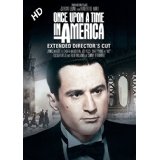
Once Upon a Time In America by Sergio Leone
Cinematic Magic
Once Upon a Time in America invites two conflicting, if perfectly valid, opinions. For example, a viewer or reviewer expecting a representative example of the genre (the gangster film) might be tempted to write:
What a dismal dud! Unless you’re twisted or insane, do not waste your time and money on this turkey. The pacing is excruciatingly slow, the plot scrambled beyond belief and the chronology confusing in the extreme. As for the sparse “action” (isn’t it supposed to be an action film?), there are a few instantly forgettable shootouts and a laughably grandiose bank-heist plan or, more exactly, a bank-robbing fantasy, doomed to failure from the start. Some gangster movie! No wonder “Once Upon a Time in America” bombed on release in 1984. Bottom line: Give it a wide berth.
But if, like me, you’re fed up with wham-bam box-office hits crammed with fast-paced action and head-spinning plot twists, get Once Upon a Time in America in any way you can. Brace yourself for a long viewing session (the runtime is 4 hours and 12 minutes), sink into your armchair and join the main character Noodles (played to perfection by Robert De Niro) on a trip down the memory lane to the Lower East Side in the 1920s, a life-changing journey from Buffalo to New York in 1968, interspersed with memories of the Great Depression and Prohibition, and finally on a visit to a New York opium den in 1934, where Noodles ends his remarkable tale (for a summary of the plot see Wikipedia).
The most memorable parts will stay with you forever, such as when Patsy, one of Noodles’s pals, devours a Charlotte Russe with Cream while waiting for Peggy, a teenage prostitute; or when Deborah (Noodles’s childhood sweetheart) reads passages from the Song of Songs, alternating poetic similes inspired by love with cruel taunting remarks about Noodles and his poor hygiene. You’ll be mesmerized by the soundtrack composed, arranged and conducted by Ennio Morricone, stunned by the phenomenal acting of all involved – the teenage actors, in particular, make an indelible impression – and captivated by the terse dialogue (Fat Moe: What have you been doing all these years? Noodles: Been goin’ to bed early. Or: Ticket Seller: Where to? Sir, where do you want to go? Noodles: Anywhere. First Bus. Ticket Seller: Buffalo? Noodles: One way. Ticket Seller: That’ll be $1.20). You’ll be fascinated by the elaborate nonlinear structure (think Annie Hall, Mulholland Drive or Pulp Fiction), composed of long flashbacks cued by well-chosen image and sound motifs.
True, you’ll be disconcerted or perhaps even shocked by the two long rape scenes (one of them, featuring Deborah, is much too long in the “Extended Director’s Cut” to be convincing artistically), the gross mistreatment of women in general, masculinity viewed as a hopeless state of mind, love depicted as a dangerous illusion, virile friendship undermined by rivalry and ultimately ruined by betrayal, or the seemingly gratuitous violence. But then, that’s what Once Upon a Time in America is all about: Moral depravity is here closely intertwined with purity and innocence, cruelty with tenderness, pain with pleasure, hate with love, the sacred with the profane, the sublime with the ridiculous and the vulgar, etc. Sergio Leone took many years and great pains to combine these disparate elements into a coherent artistic whole.
For that, we should be grateful to him.
© by Krzysztof Mąkosa
Director: Sergio Leone
Starring: Robert De Niro, James Woods
Supporting Actors: Elizabeth McGovern, Joe Pesci, Burt Young, Tuesday Weld, Treat Williams, Danny Aiello, Richard Bright, James Hayden, William Forsythe, Darlanne Fleugel, Jennifer Connelly, et al.
